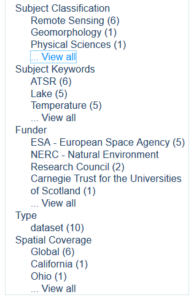I was asked recently on Twitter if our data library was still happily using DSpace for data – the topic of a 2009 presentation I gave at a DSpace User Group meeting. In responding (answer: yes!) I recalled that I’d intended to blog about some of the rich new features we’ve either adopted from the open source community or developed ourselves to deliver our data users and depositors a better service and fulfill deliverables in the University’s Research Data Management Roadmap.
Edinburgh DataShare was built as an output of the DISC-UK DataShare project, which explored pathways for academics to share their research data over the Internet at the Universities of Edinburgh, Oxford and Southampton (2007-2009). The repository is based on DSpace software, the most popular open source repository system in use, globally. Managed by the Data Library team within Information Services, it is now a key component in the UoE’s Research Data Programme, endorsed by its academic-led steering group.
An open access, institutional data repository, Edinburgh DataShare currently holds 246 datasets across collections in 17 out of 22 communities (schools) of the University and is listed in the Re3data Registry of Research Data Repositories and indexed by Thomson-Reuters’ Data Citation Index.
Last autumn, the university joined DataCite, an international standards body that assigns persistent identifiers in the form of Digital Object Identifiers (DOIs) to datasets. DOIs are now assigned to every item in the repository, and are included in the citation that appears on each landing page. This helps to ensure that even after the DataShare system no longer exists, as long as the data have a home, the DOI will be able to direct the user to the new location. Just as importantly, it helps data creators gain credit for their published data through proper data citation in textual publications, including their own journal articles that explain the results of their data analyses.
 The autumn release also streamlined our batch ingest process to assist depositors with large and voluminous data files by getting around the web upload front-end. Currently we are able to accept files up to 10 GB in size but we are being challenged to allow ever greater file sizes.
The autumn release also streamlined our batch ingest process to assist depositors with large and voluminous data files by getting around the web upload front-end. Currently we are able to accept files up to 10 GB in size but we are being challenged to allow ever greater file sizes.
Making the most of metadata
Every landing page (home, community, collection) now has a ‘Discover’ panel giving top hits for each metadata field (such as subject classification, keyword, funder, data type, spatial coverage). The panel acts as a filter when drilling down to different levels, allowing the most common values to be ‘discovered’ within each section.
The usage statistics at each level are now publicly viewable as well, so depositors and others can see how often an item is viewed or downloaded. This is useful for many reasons. Users can see what is most useful in the repository; depositors can see if their datasets are being used; stakeholders can compare the success of different communities. By being completely open and transparent, this is a step towards ‘alt-metrics’ or alternative ways measuring scholarly or scientific impact. The repository is now also part of IRUS-UK, (Institutional Repository Usage Statistics UK), which uses the COUNTER standard to make repository usage statistics nationally comparable.
What’s coming?
Stay tuned for future improvements around a new look and feel, preview and display by data type, streaming support, bittorent downloading, and Linked Open Data.
Robin Rice
EDINA and Data Library

